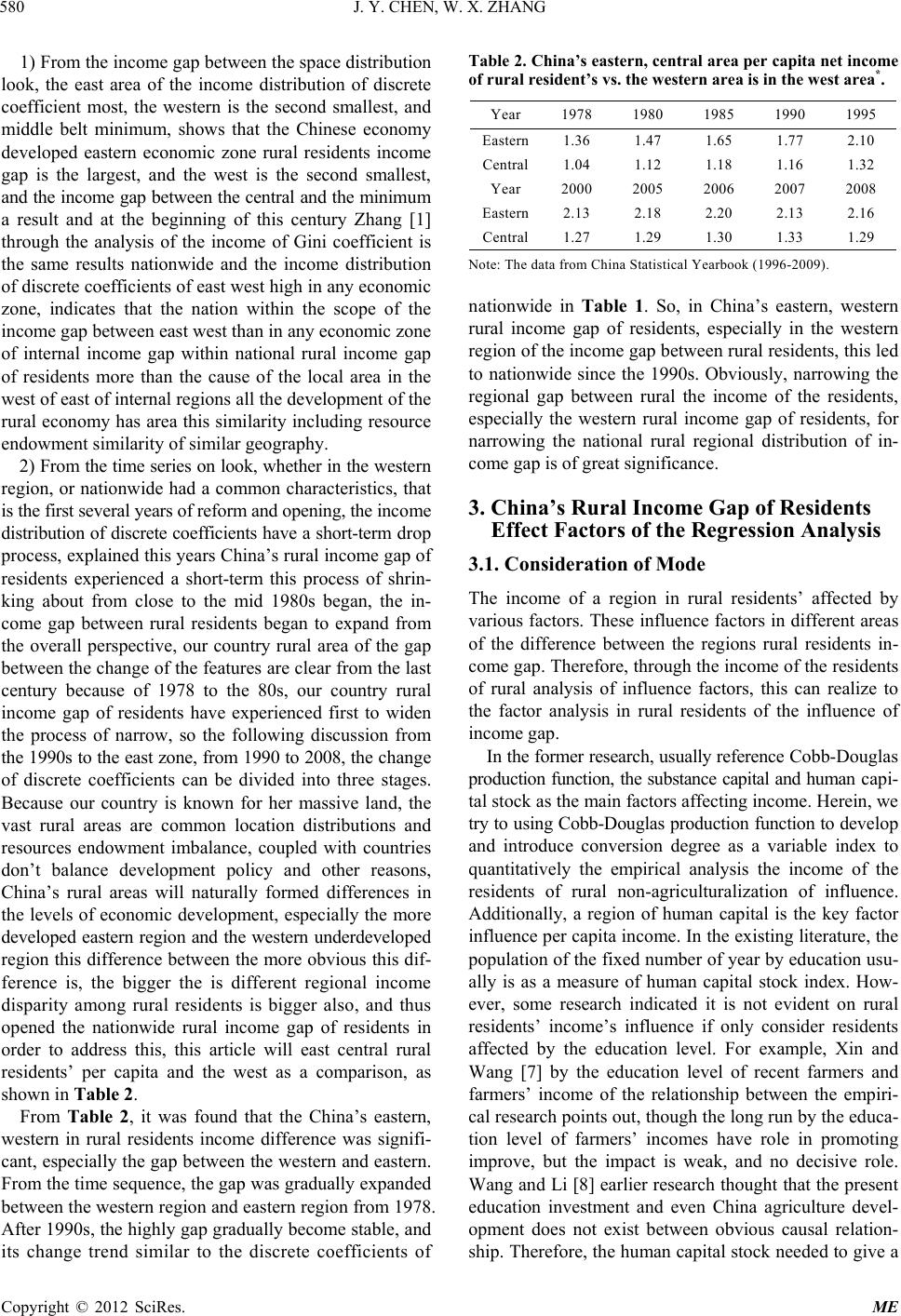
J. Y. CHEN, W. X. ZHANG
580
1) From the income gap between the space distribution
look, the east area of the income distribution of discrete
coefficient most, the western is the second smallest, and
middle belt minimum, shows that the Chinese economy
developed eastern economic zone rural residents income
gap is the largest, and the west is the second smallest,
and the income gap between the central and the minimu m
a result and at the beginning of this century Zhang [1]
through the analysis of the income of Gini coefficient is
the same results nationwide and the income distribution
of discrete coefficients of east west high in any economic
zone, indicates that the nation within the scope of the
income gap between east west than in any economic zone
of internal income gap within national rural income gap
of residents more than the cause of the local area in the
west of east of internal regions all the development of the
rural economy has area this similarity including resource
endowment similarity of similar geography.
2) From the time series on look, whether in the western
region, or nationwide had a common characteristics, that
is the first several years of reform and opening, the income
distribution of discrete coefficients have a short-term d rop
process, explained this years China’s rural income gap of
residents experienced a short-term this process of shrin-
king about from close to the mid 1980s began, the in-
come gap between rural residents began to expand from
the overall perspective, our country rural area of the gap
between the change of the features are clear from the last
century because of 1978 to the 80s, our country rural
income gap of residents have experienced first to widen
the process of narrow, so the following discussion from
the 1990s to the east zone, from 1990 to 2008, the ch ange
of discrete coefficients can be divided into three stages.
Because our country is known for her massive land, the
vast rural areas are common location distributions and
resources endowment imbalance, coupled with countries
don’t balance development policy and other reasons,
China’s rural areas will naturally formed differences in
the levels of economic development, especially the more
developed eastern region and the western underdeveloped
region this difference between the more obvious this dif-
ference is, the bigger the is different regional income
disparity among rural residents is bigger also, and thus
opened the nationwide rural income gap of residents in
order to address this, this article will east central rural
residents’ per capita and the west as a comparison, as
shown in Table 2.
From Table 2, it was found that the China’s eastern,
western in rural residents income difference was signifi-
cant, especially the gap between the western and eastern.
From the time sequence, the gap was gradually expanded
between the western region and eastern region from 1978.
After 1990s, the highly gap gradually become stable, and
its change trend similar to the discrete coefficients of
Table 2. China’s eastern, central area per capita net income
of rural resident’s vs. the western area is in the west area*.
Year 1978 1980 1985 1990 1995
Eastern1.36 1.47 1.65 1.77 2.10
Central1.04 1.12 1.18 1.16 1.32
Year 2000 2005 2006 2007 2008
Eastern2.13 2.18 2.20 2.13 2.16
Central1.27 1.29 1.30 1.33 1.29
Note: The data from China Statistical Yearbook (1996-2009).
nationwide in Table 1. So, in China’s eastern, western
rural income gap of residents, especially in the western
region of the income gap between rural residents, this led
to nationwide since the 1990s. Obviously, narrowing the
regional gap between rural the income of the residents,
especially the western rural income gap of residents, for
narrowing the national rural regional distribution of in-
come gap is of great significance.
3. China’s Rural Income Gap of Residents
Effect Factors of the Regression Analysis
3.1. Consideration of Mode
The income of a region in rural residents’ affected by
various factors. These influence factors in different areas
of the difference between the regions rural residents in-
come gap. Therefore, through the income of the residents
of rural analysis of influence factors, this can realize to
the factor analysis in rural residents of the influence of
income gap.
In the former research, usually reference Co bb -Do ug la s
production function, the substance capital and human c api-
tal stock as the main factors affecting inco me. Herein, we
try to using Cobb-Douglas production function to develo p
and introduce conversion degree as a variable index to
quantitatively the empirical analysis the income of the
residents of rural non-agriculturalization of influence.
Additionally, a region of human capital is the key factor
influence per capita income. In the existing literature, the
population of the fixed number of year by education usu-
ally is as a measure of human capital stock index. How-
ever, some research indicated it is not evident on rural
residents’ income’s influence if only consider residents
affected by the education level. For example, Xin and
Wang [7] by the education level of recent farmers and
farmers’ income of the relationship between the empiri-
cal research points out, though the long run by the educa-
tion level of farmers’ incomes have role in promoting
improve, but the impact is weak, and no decisive role.
Wang and Li [8] earlier research thou ght that the present
education investment and even China agriculture devel-
opment does not exist between obvious causal relation-
ship. Therefore, the human capital stock needed to give a
Copyright © 2012 SciRes. ME